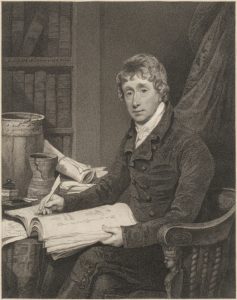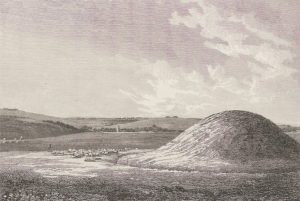Enlightened Landscapes
Notizen aus dem Gothaer Bibliotheksturm, Folge 18

Ill. 1: Portrait of Richard Colt Hoare. (CC BY-SA 4.0)
The Gotha Research Library has an outstanding collection of historical works on archaeology. Those from the ducal holdings are recorded in the voluminous hand-written „Catalogus Bibliothecae Antiquariae-Archaeologicae.“ Besides prominent 18th and 19th-century works on the monuments, inscriptions and antiquities of the Mediterranean and Near East, the collection comprises well-known publications in all areas of European antiquarianism.
Nonetheless, a seminal work for the history of European archaeology was missing hitherto: The History of Ancient Wiltshire (1812–1819) by Richard Colt Hoare (1758–1838), an immensely wealthy financier and patron of the painter William Turner.
Hoare, owner of the neo-palladian villa Stourhead in the county of Wiltshire, redesigned the famous garden attached to his residence. He was also a keen traveller until his interests turned to the history and monuments of his homeland. Hoare widened the vista from his classical landscape garden (a scenery featuring antique architecture, a grotto and a Gothic house around a lake) to the surrounding countryside where sheep grazed the grasslands covering prehistoric barrows and hillforts.

Ill. 2: Barrow near Avebury. © Forschungsbibliothek Gotha (CC BY-SA 4.0).
Artificial mounds like Silbury Hill and megalithic monuments like Stonehenge or Avebury had posed riddles since medieval times. Contemporaries sensed beauty and the sublime in such fascinating relics of the past as they did in the classical landscape garden. Together with William Cunnington, Hoare had labourers excavate more than 300 prehistoric barrows scattered across the Salisbury Plain. The History of Ancient Wiltshire was an archaeo-topographical account of Hoare’s home county, presenting a barrow typology as well as dealing with remains testifying to the ancient Britons and the Romans under the positivistic motto: „We speak from facts, not theory.“
The Gotha Research Library recently acquired all three parts of Hoare’s History of Ancient Wiltshire in two volumes, illustrated with engraved plates and maps. Fellow antiquary John Britton criticised the “unpleasant unwieldy and expensive size”, but the Gotha copy is the product of a smaller print run on even larger paper, measuring 46 x 52 cm. It was perhaps the truly megalithic format and heavy weight that impeded the dissemination of the work to the European continent. Its impact on scholarship beyond England still awaits further study. Johann Wolfgang von Goethe borrowed the first volume of the work in June 1816 from the Ducal Library in Weimar. However, the other two parts were never acquired. The only German library to have held a complete copy was the Berlin State Library; sadly, it was lost in World War II. The complete copy of The History of Ancient Wiltshire in the Gotha Research Library has recently been digitized and can now be freely accessed under this URL.
Author: Dr. Dietrich Hakelberg, October 5, 2020
Bibliography
Woodbridge, K. Landscape and Antiquity. Aspects of English Culture at Stourhead (Oxford 1970).
![]() Dieser Text steht unter der Lizenz Creative Commons Namensnennung – Weitergabe unter gleichen Bedingungen 4.0 International – CC BY-SA 4.0. Bitte nennen Sie bei einer möglichen Nachnutzung den angegebenen Autorennamen sowie als Quelle das Blog der Forschungsbibliothek Gotha.
Dieser Text steht unter der Lizenz Creative Commons Namensnennung – Weitergabe unter gleichen Bedingungen 4.0 International – CC BY-SA 4.0. Bitte nennen Sie bei einer möglichen Nachnutzung den angegebenen Autorennamen sowie als Quelle das Blog der Forschungsbibliothek Gotha.